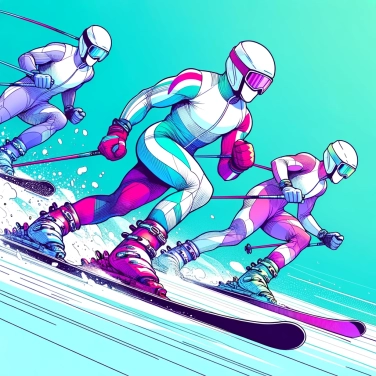Skiers wear tight-fitting suits to reduce aerodynamic drag, improve their speed and performance on the slopes.

Skiers wear skin-tight suits primarily because they minimize air resistance. Less resistance means better air penetration, leading to higher speeds. These tight outfits prevent wrinkles that can trap air and create a miniaturized parachute effect. The result: you glide faster with less wasted effort. In competition, winning by a fraction of a second can change everything, so every little aerodynamic detail counts significantly.
The tight-fitting suits of skiers are designed to directly follow the body's movements without hindrance. Their very elastic and snug fabric mainly allows the athlete to move with precision, agility, and speed in sharp turns. When you descend a slope at full speed, every little movement counts: your outfit must remain perfectly close to your body to avoid any discomfort during your descent. This maximum freedom allows for improved balance, comfort in effort, and of course, performance. Flexibility, ease, and control are therefore present thanks to these fitted suits.
These form-fitting suits keep you warm thanks to their special technical material. Often designed with specific fabrics, they retain heat against your body and prevent cold or outside moisture from bothering you. With their second skin effect, they also reduce body heat loss while remaining comfortable. Even in freezing temperatures, they allow you to ski for a long time without feeling cold.
Form-fitting suits reduce the risk of falls by preventing the garment from catching on a door or a post during fast descents. In case of a fall, they significantly lower the risks related to friction or abrasion injuries thanks to their resistant material that fits closely to the body. Additionally, these suits simplify rescue interventions, particularly facilitating rapid care in case of injury. Finally, their close-fitting design provides better visibility for officials to monitor the skier's positions and ensure compliance with competition regulations.
The fitted suit of a professional skier is often made from special fabrics that maximize aerodynamics while keeping the body at an optimal temperature, even at -20°C.
To validate a combination in official competition, the International Ski Federation (FIS) regularly conducts strict checks on the thickness, porosity, and structure of the fabric to ensure fair conditions for all athletes.
Athletes sometimes use slightly textured suits, similar to golf balls, because certain specific textures can reduce air turbulence and further enhance glide.
Did you know that speed skiers wear aerodynamic suits specifically designed to reach speeds of over 250 km/h? These extreme performances require particularly durable textiles and a design perfectly tailored to each athlete.
The form-fitting suit alone offers limited protection against injuries in the event of a fall; however, in certain competitions, it can be combined with built-in protections or worn with specific undergarments featuring protective padding.
It is not essential; skintight suits are primarily used by competitive skiers to gain speed and precision. For recreational skiing, it is generally sufficient to wear comfortable clothing that is suitable for the weather conditions.
Form-fitting outfits are typically made from synthetic fabrics such as Lycra, spandex fiber, or they may incorporate polyester. These materials provide optimal breathability, elasticity, and thermal protection.
It is recommended to follow the instructions on the manufacturer's label. Generally, a form-fitting suit should be hand-washed or washed on a delicate cycle at low temperature, without fabric softener, to maintain its elasticity and thermal properties.
Yes, form-fitting suits are specially designed with soft and stretchy materials, providing optimal comfort and maximum freedom of movement while reducing aerodynamic drag.

No one has answered this quiz yet, be the first!' :-)
Question 1/4